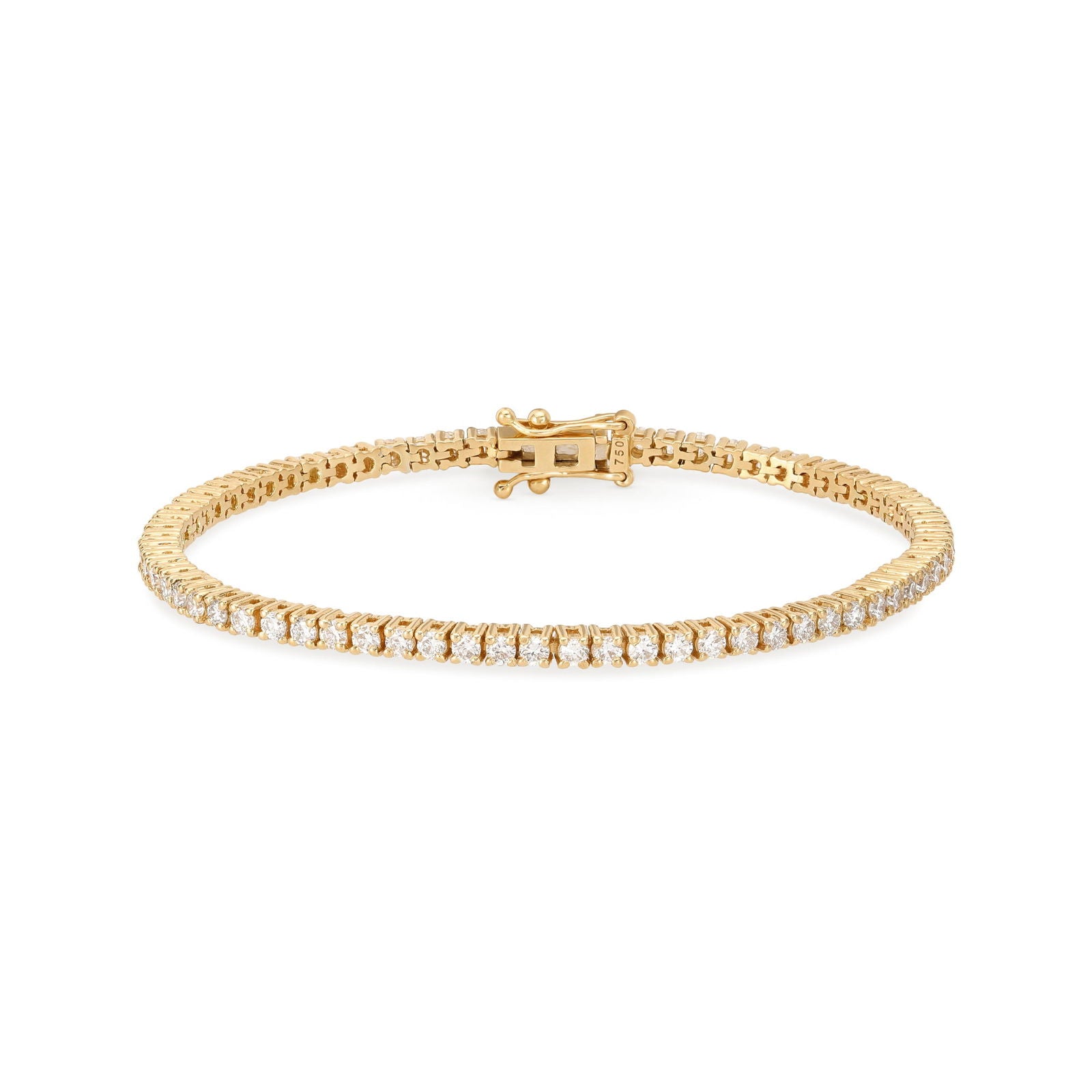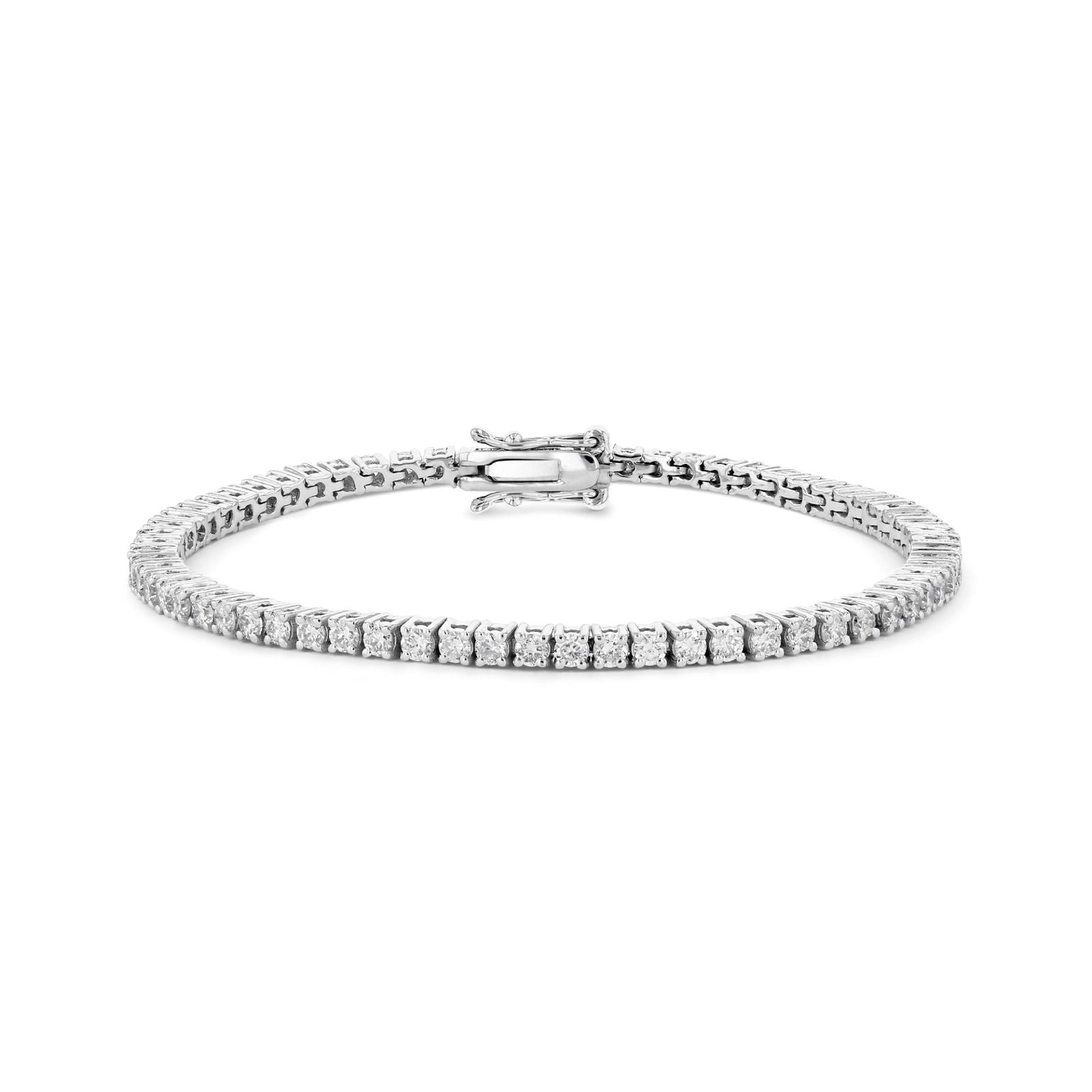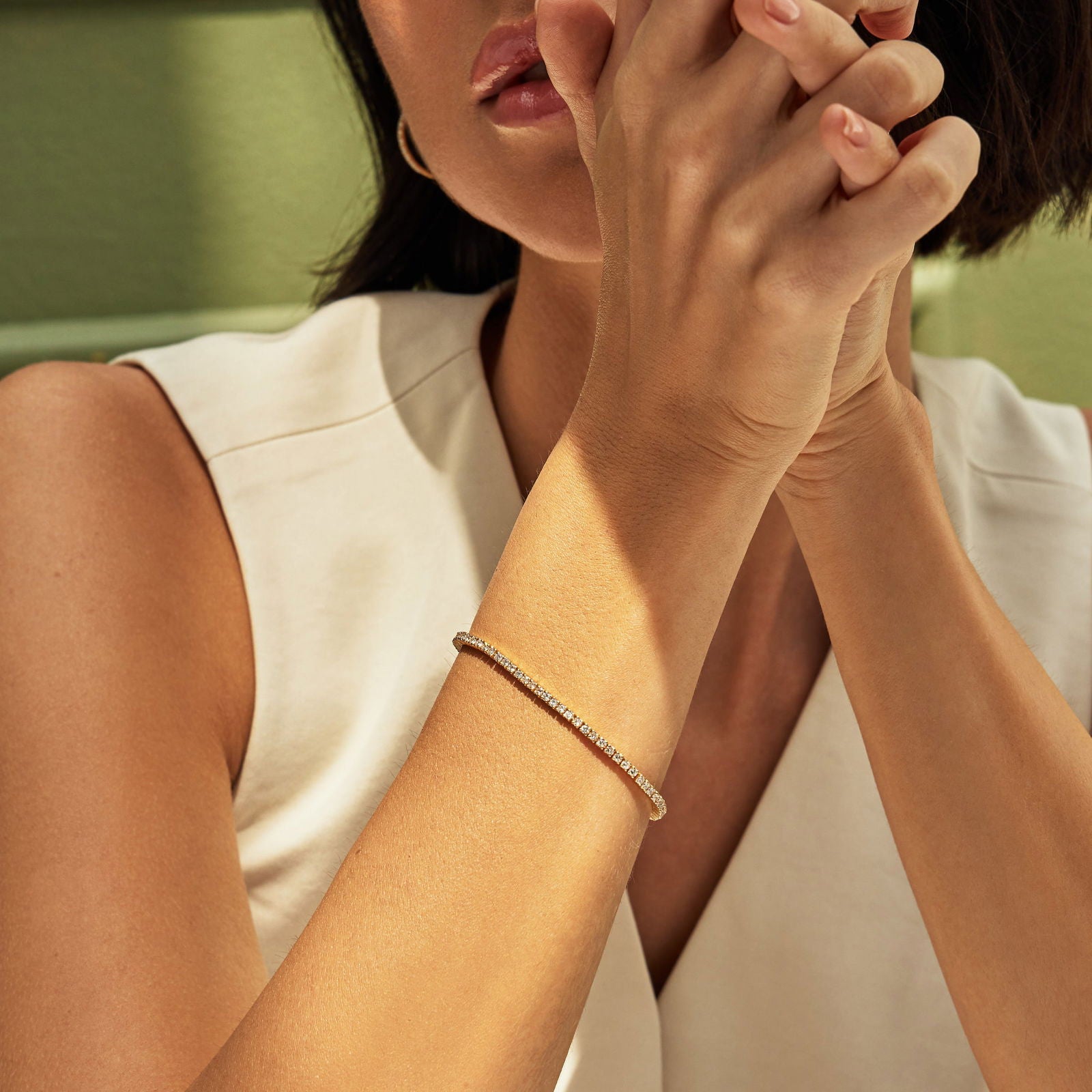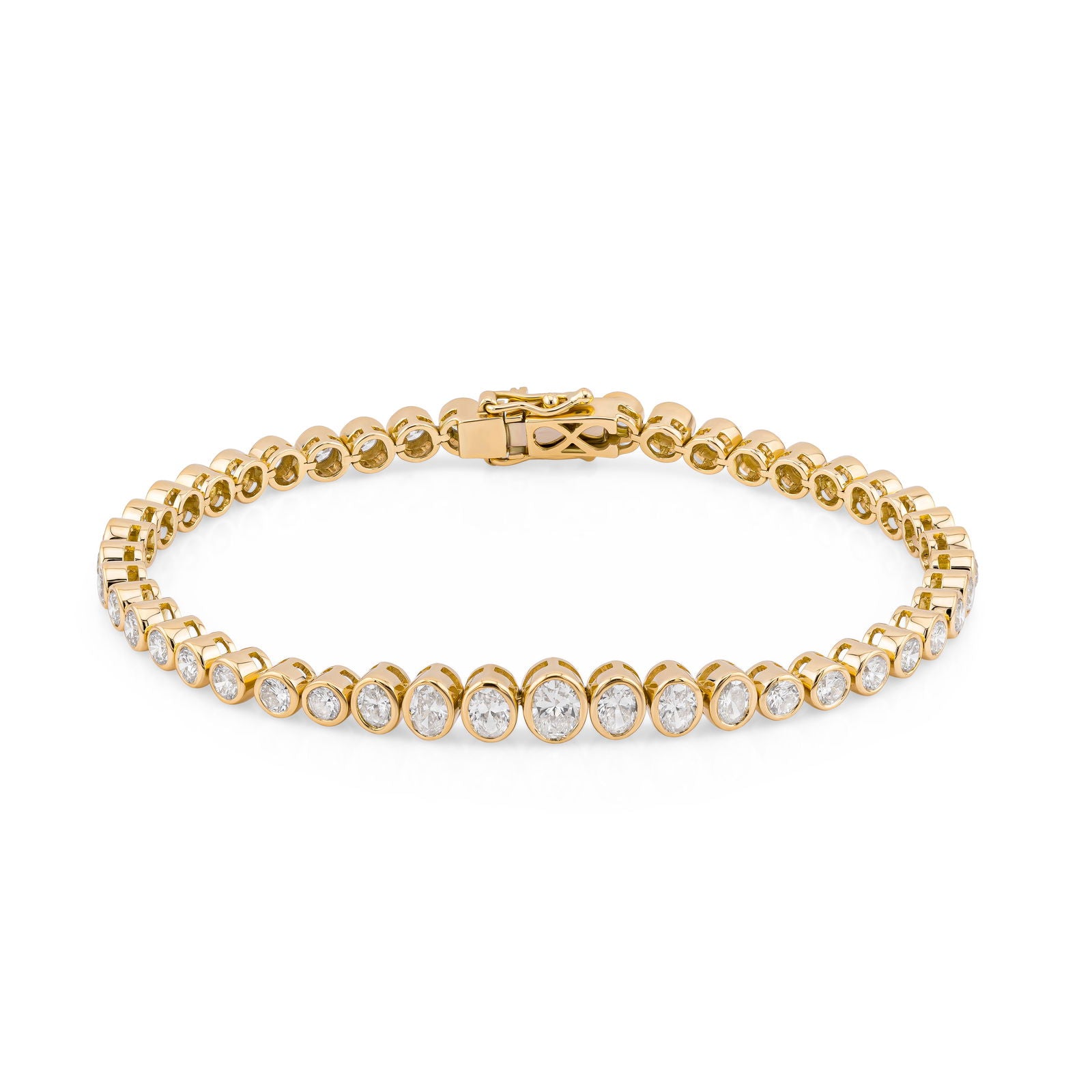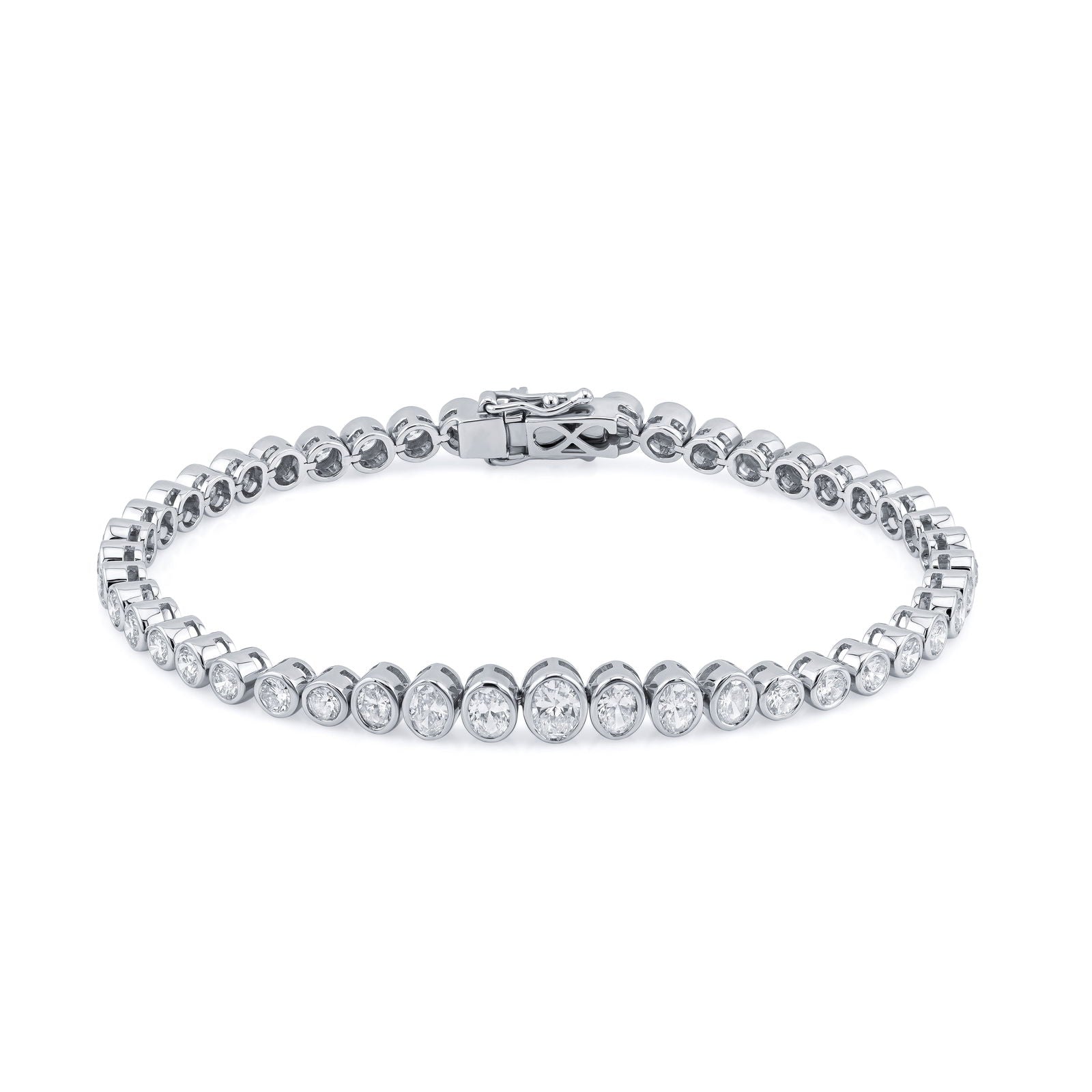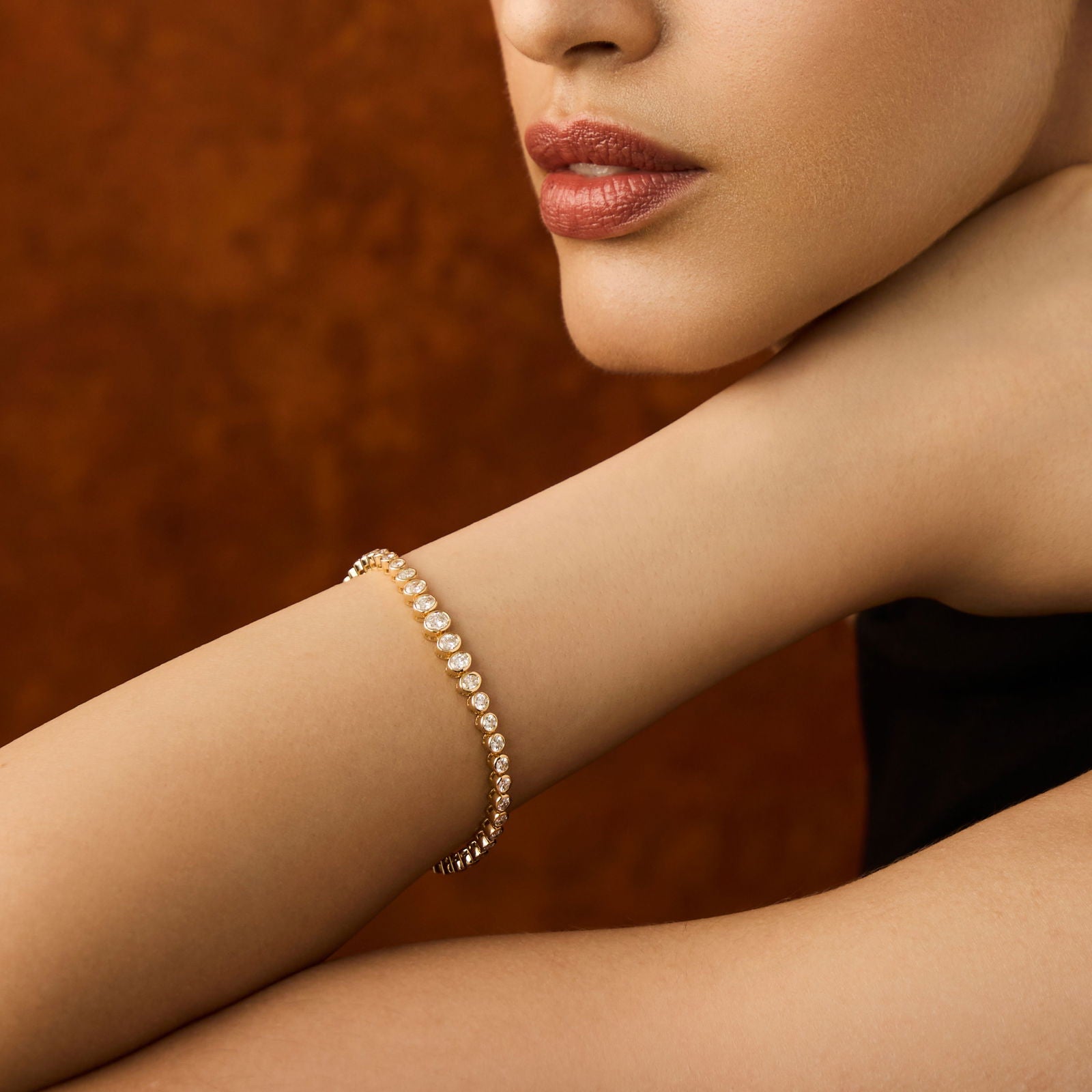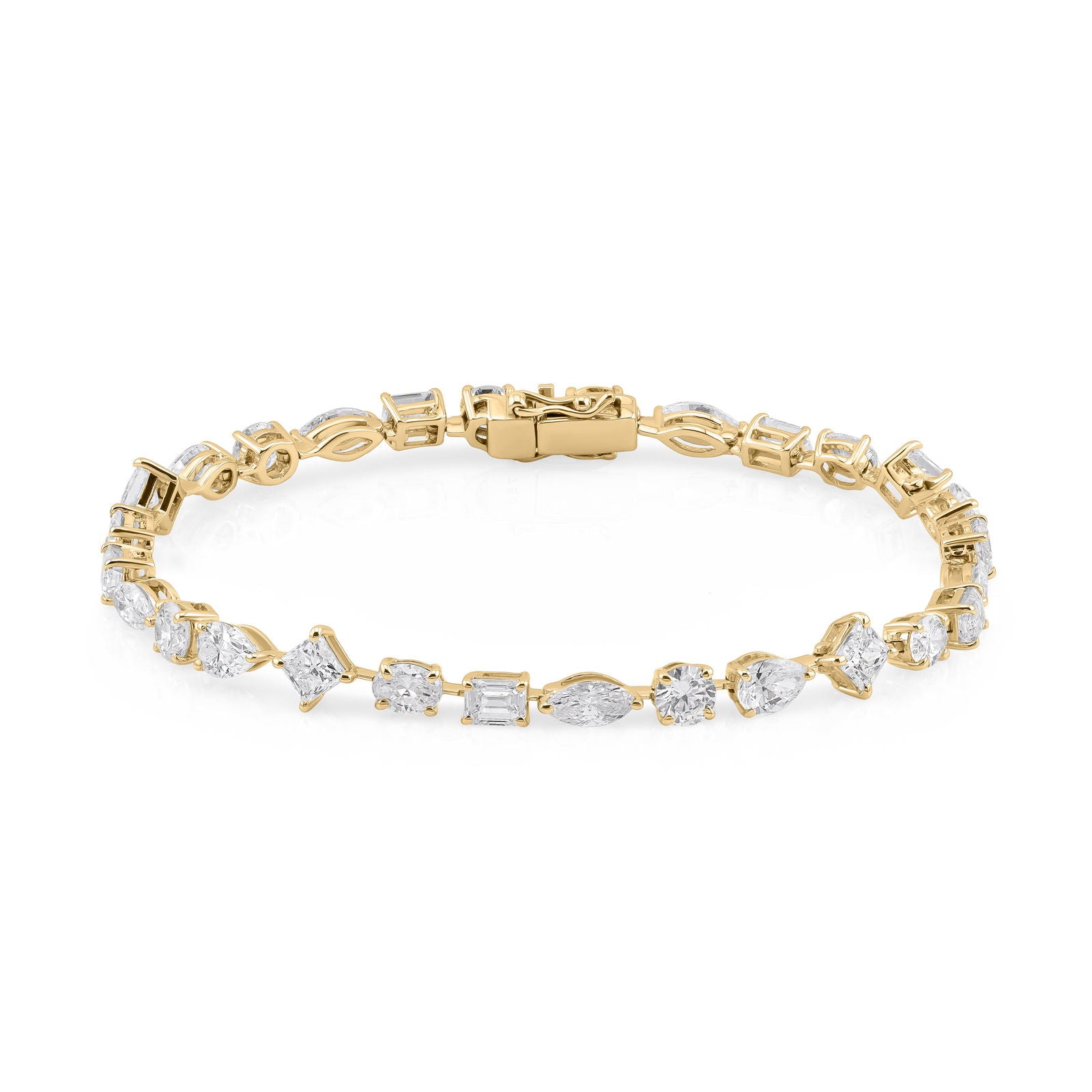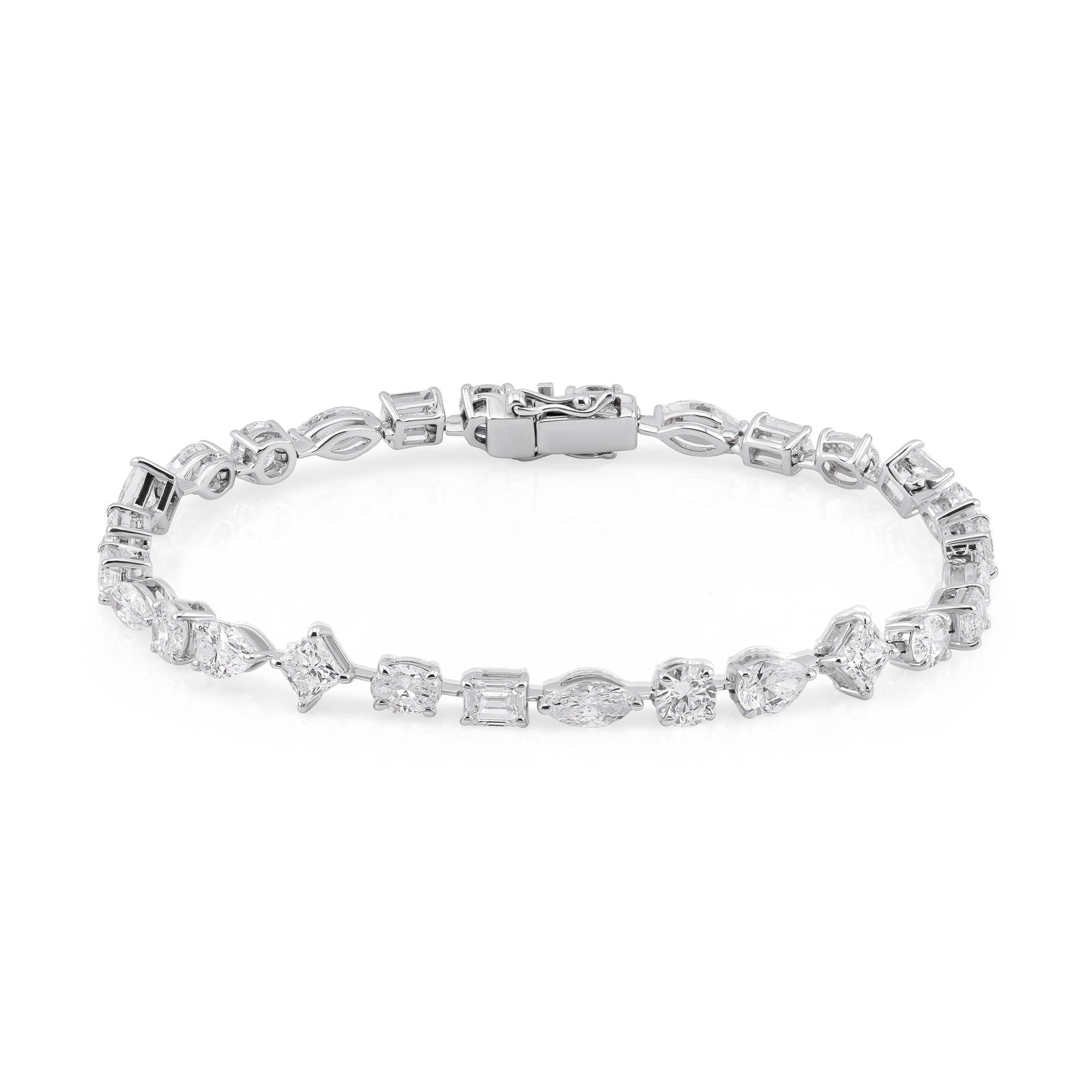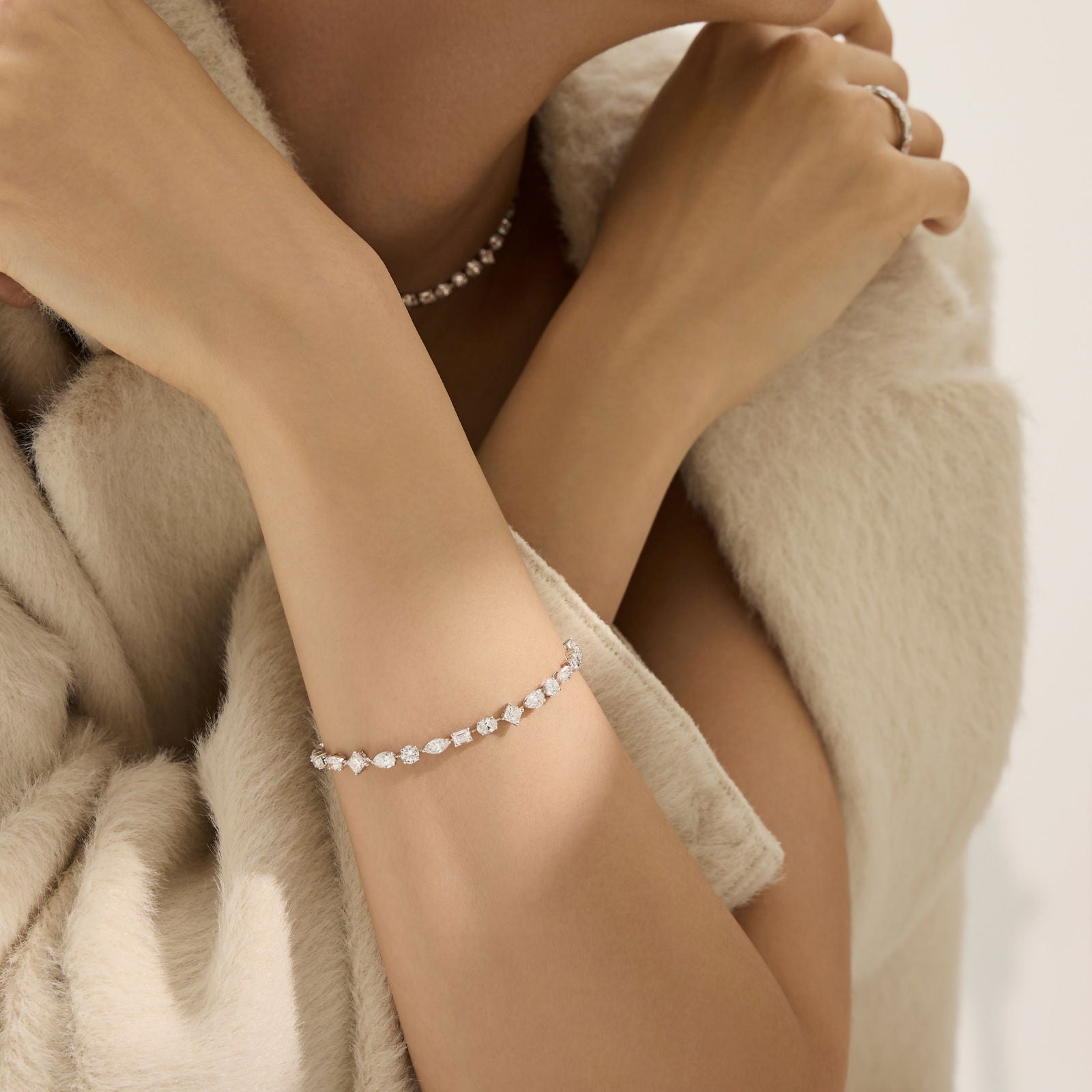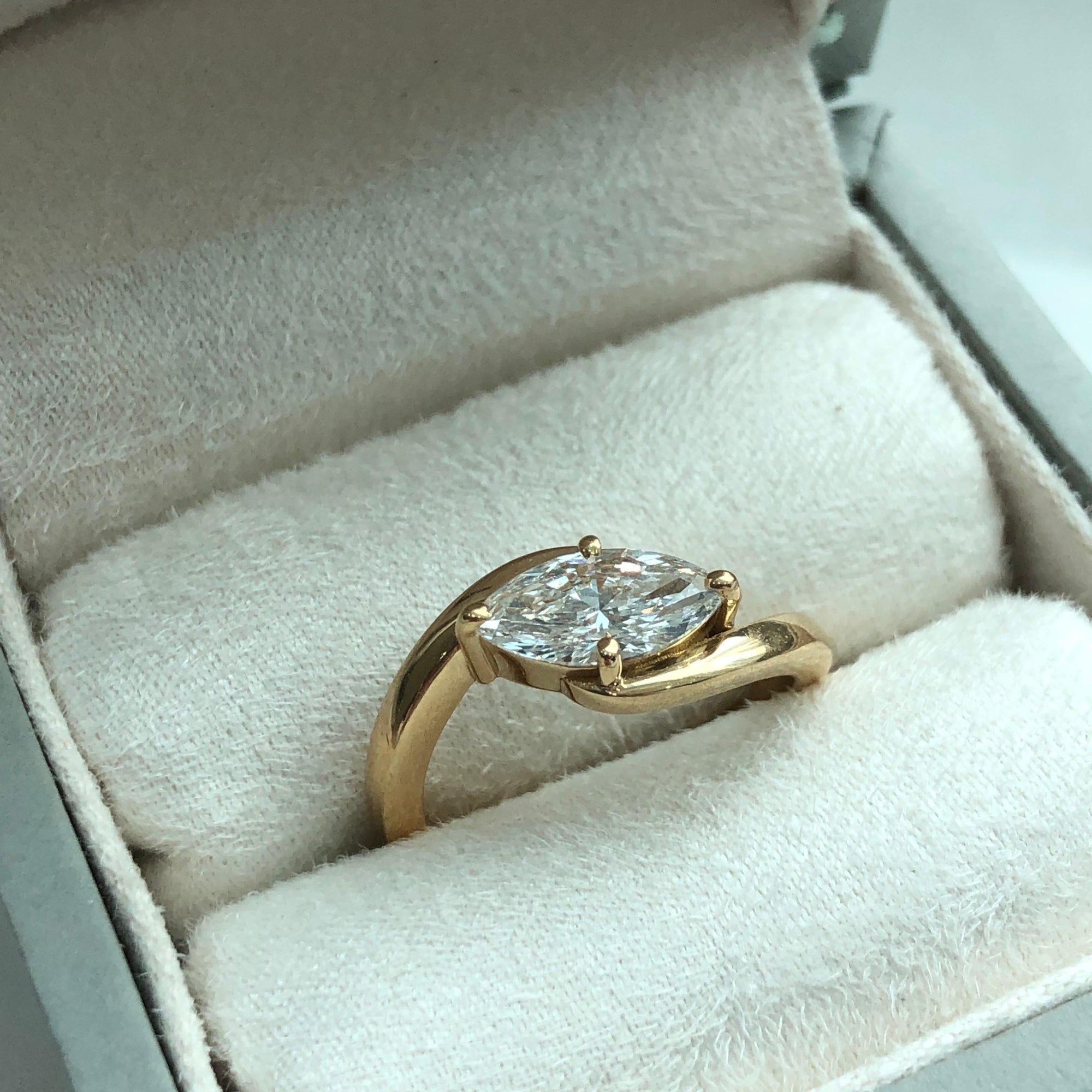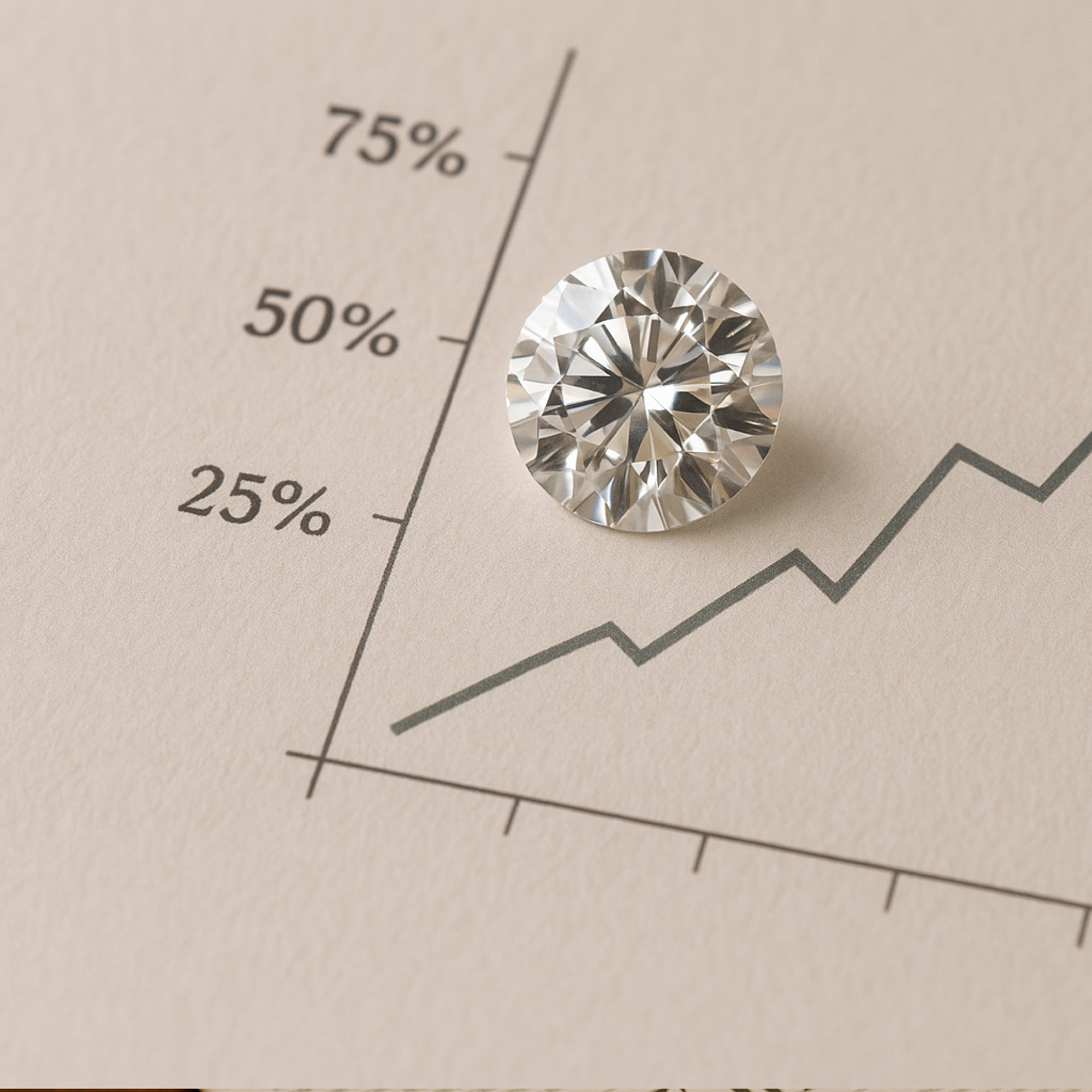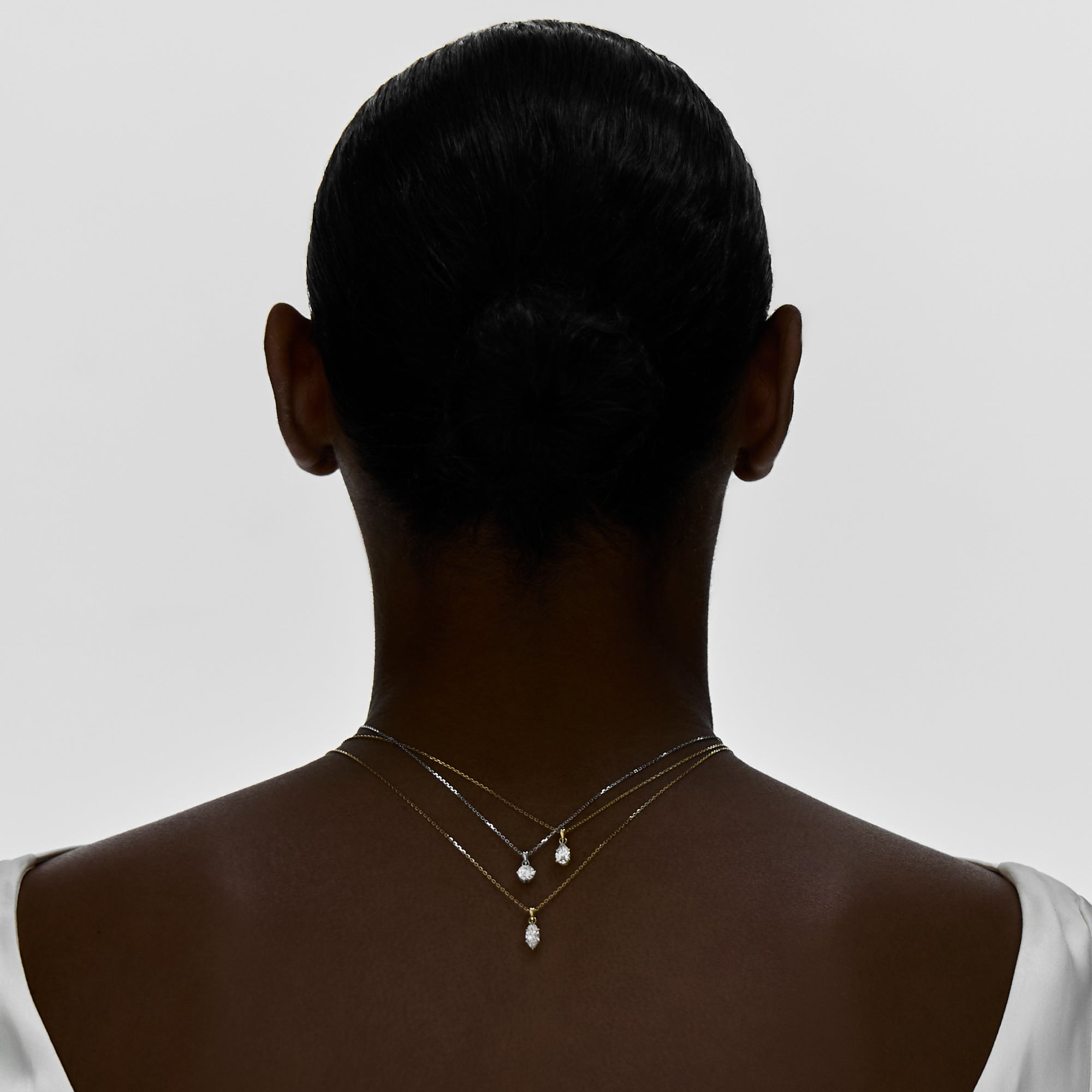A tennis bracelet could be your ideal match if you are dreaming of diamonds. Why have one VVS diamond when you can have a string of identical sparkling gems set in 18k gold poised on your wrist?
Learn about the tennis bracelet origin, different tennis bracelet styles, and figure out which Fyne diamond tennis bracelet is the one for you in this complete guide.
What is a Tennis Bracelet?
Let’s start with the basics: what’s a tennis bracelet? A diamond tennis bracelet is a continuous string of connected diamonds that sit around the wearer’s wrist, secured by a clasp. It’s a wise idea to have a safety clasp added to your design of choice—you’ll understand why later!
Classic tennis bracelets feature diamonds that match perfectly in every way. Each stone is identical and chosen to create a flawless, symmetrical look. Nowadays, jewellers have unleashed their creativity in line with consumer demand, and some pieces use multi-shape diamonds and even different types of gems. However, this doesn’t mean that they’re placed outside the category of tennis bracelets. The important thing is that the stones are linked continuously, and the bracelet is flexible.
Did you know? Fyne’s diamond tennis bracelets incorporate 18k gold and ethical lab-grown diamonds, making them the perfect choice for the conscientious shopper. Among our collection, choose from a classic, identical string of diamonds or a more daring multi-shape diamond tennis bracelet.
Why Are They Called Tennis Bracelets?
If you've ever wondered about the tennis bracelet meaning, it stems from a famous incident involving tennis star Chris Evert. During an important match, she lost her diamond bracelet and requested that the game be paused so she could look for it. This is the event that coined the term we use today, inspiring jewellers to work on more secure fastenings. It’s also why we suggest adding a safety catch to your bracelet!
For those interested in tennis bracelet history before the Evert event in 1987, the jewellery pieces were called eternity bracelets. This is likely due to the continuous string of identical diamonds that make up the bracelets. Eternity rings, however, still keep this name (symbolising a never-ending love).
Tennis Bracelet Design: Different Settings
You can choose between identical diamonds in your tennis bracelet or one that features a mix of different diamond types (or other gemstones). Additionally, there are various settings, which refer to how the gold is attached to the diamonds. The setting plays a key role in a bracelet’s aesthetics and durability. Here are some of the most popular settings:
Which Option is Right for You?
Ultimately, the choice is yours. If time and budget are no inconvenience, custom jewellery design is the way forward, allowing you to design the ring of your dreams. But with thousands of beautiful designs already available and the ability to order from anywhere worldwide, you can always find a beautiful ready-made ring that is equally as high-quality and sentimental as a custom-made option.
Did you know? At Fyne, we offer a whole range of bridal jewellery, from tennis necklaces to lab-grown diamond earrings. Shop our bridalwear collection here.
Prong Setting
Best for a Classic Aesthetic
The prong setting typically features four prongs that securely grip the diamond in place. Part of the sides of the diamonds are uncovered with this setting, meaning more light can shine through each one, and the gems will sparkle more brightly than with some other settings.
This setting is often regarded as less secure than, for example, the bezel setting, but professional jewellers design tennis bracelets and necklaces to last; a prong setting is a perfectly viable choice when buying from a reputable jeweller.
Bezel Setting
Best for daily wear
In tennis bracelet design, a bezel setting is where the metal wraps around the diamonds, encasing them. It’s one of the most secure settings, and the gold-to-diamond ratio makes them visually appealing. However, because more of the diamond is covered by the gold (or other metal), the diamond can appear less brilliant at times.
Channel Setting
Best for seamless style and security
What makes a tennis bracelet unique is its design: a continuous line of individually set diamonds (or gemstones), connected by small metal links that allow the bracelet to bend and move with the wrist. That flexibility is essential to both the look and the comfort of a tennis bracelet. However, the channel setting involves placing the diamonds between two continuous outer lines of gold.
How does the channel setting work if this flexibility is required?
In tennis bracelets, channel settings are specially engineered to maintain flexibility by using segmented channels or placing a few stones within each link, rather than a single, continuous, rigid channel. This setting allows the bracelet to move while still giving the sleek look of a channel-set design. A truly rigid channel, such as in some bangles, would not technically be considered a tennis bracelet.
> Shop the Noor Eternity Ring, featuring a channel set design
Choosing the Right Tennis Bracelet
Choosing the perfect tennis bracelet is about more than just sparkle — it's about finding tennis bracelet styles that suit your style, lifestyle, and budget. Here are some key factors to consider:
Metal Type
Fyne’s bracelets are set in 18k gold. Our unique, sustainable collection offers a choice between white and yellow gold. While the hues differ, white, yellow, and rose gold have an equal amount of gold karat weight — and as a result, are similarly valuable. In that aspect, it ultimately comes down to personal choice.
Ask yourself: Will I wear my diamond tennis bracelet with my other jewellery? Do I want something different from my usual style to wear as a singular statement piece? Which colour of gold do I prefer?
Setting Style
Tennis bracelet styles differ according to their setting. We’ve covered prong, bezel and channel settings for tennis bracelets. The one you choose will depend on your lifestyle, as well as personal preference. For example, a prong setting gives you a diamond tennis bracelet that sparkles more, whereas a bezel setting is generally classed as the most secure option. For the most seamless look, choose a channel setting.
Ask yourself: Do I want this bracelet for special occasions or daily wear? If it’s for special occasions, a prong setting might be right for you. If your bracelet is intended for daily wear, you may prefer a bezel setting. Remember, even if you opt for a prong setting, you can wear your bracelet with confidence; just take extra care to maintain it.
Diamond Quality
The 4 Cs of diamonds — cut, colour, clarity, and carat — are key to understanding diamond quality and value. With tennis bracelets, lower clarity and colour grades are often less noticeable due to the smaller size of each individual stone. That means you can prioritise cut and carat while compromising slightly on clarity and colour, helping you stay within budget without compromising on beauty.
Ask yourself: Am I willing to trade a little perfection for a lot of sparkle within my price range?
Length and Fit
A tennis bracelet should allow for a little movement around your wrist, but not be so long that it can slide over your hand. Fyne’s tennis bracelets can be 15cm, 16cm or 17cm in length. For custom sizing, speak to our team to discuss your options.
Ask yourself: What length do I need? You can wrap a piece of string around your wrist, allow two fingers to fit underneath, and measure the string against a ruler.
Budget
There is a wide price range, depending on the metal, total carat weight, and craftsmanship. Set a realistic budget and look for a well-balanced piece that delivers on beauty and durability.
Ask yourself: What is my budget? Can I go over budget if a payment plan is an option?
How to Care for Your Tennis Bracelet
To take extra care of your tennis bracelet, follow a few simple steps. We suggest:
- Remove your bracelet when cleaning, washing or applying lotions to avoid the grease build-up
- Store your bracelet away from other jewellery to prevent scratches on any piece
- Remove your bracelet when doing more physical activities
- Wear your bracelet on your left wrist if you’re right-handed, and vice versa
Final Words
Now you have the answer to ‘What is a tennis bracelet?’. The origins of the tennis bracelet date back to when tennis player Chris Evert lost hers during a match and paused the game to find it — an event that inspired jewellers to work on more secure fastenings. Now, Tennis bracelets are a popular choice for both their durability and aesthetics, featuring a flexible design with a continuous string of sparkling diamonds. At Fyne, we feature Classic tennis bracelets with identical diamonds, as well as more modern designs with diamonds of different sizes and cuts. We’ve carefully crafted each one with our sustainable ethos in mind — pieces we hope will form a part of your capsule wardrobe and be worn for a lifetime.
>Browse our sustainable collection of lab-grown tennis bracelets


